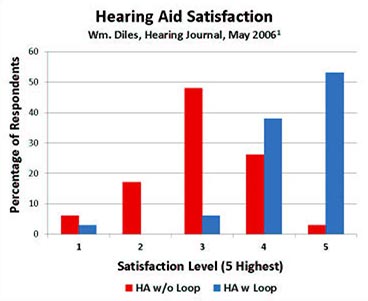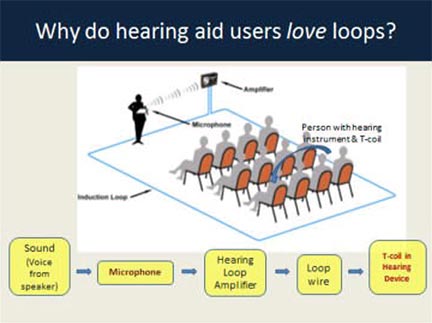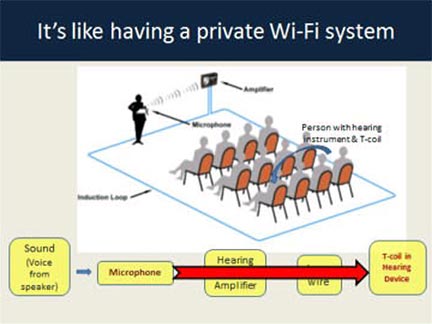Improve Client Satisfaction and Build Your Practice
Audiologists are uniquely positioned to recommend a simple well-established technology to improve their clients’ satisfaction with hearing aids, improve their communities, and, in doing so, build their practices.
Most auditorium-type venues provide an assistive listening solution such as an infrared or FM transmitting system that requires a user to check-out and wear a receiver and headset. This type of solution allows the venue owner to meet minimum legal requirements, but it rarely fills its intended purpose. Wearing a headset often is socially, and sometimes physically, uncomfortable. Venue managers also bear responsibility for battery maintenance and headset hygiene for a seldom-used system.
As for the effectiveness of a headset solution, there are probably more people at any given event who choose to not hear clearly than to wear a headset. A hearing loop system installed in a venue, however, provides a solution desirable for both attendees and the venue manager.
In a house of worship, concert hall, classroom, amphitheater – or any similar environment in which hearing a speaker, performers, or recorded sound through hearing aids is difficult – a hearing loop system enables users of hearing aids to hear clearly and comfortably without having to use any special equipment. A hearing loop, installed at the site, delivers the desired sound electronically and wirelessly – directly to people’s existing hearing aids and cochlear implants. The venue manager appreciates the loop because it helps people hear while requiring no maintenance. Houses of worship and performing arts halls that are funded largely by contributions can benefit significantly by offering their hearing aid using members and patrons a special environment in which they can hear clearly. When users of hearing aids discover a venue in which they can hear clearly and comfortably, it naturally becomes a favourite place! They tell their friends, who may or may not yet use hearing aids, and demand in the area for the expertise of audiologists rises.
The use of hearing loops is widespread in Europe and Great Britain and is on the upswing in North America. The growing momentum in popularity and use of hearing loops in the United States began by happenstance in 1999 during a vacation to Great Britain by Dr. David Myers and his wife. Dr. Myers, a hearing aid user and psychology professor at Hope College in Holland, Michigan, has spent much of his career researching the effects of hearing loss. He is a prolific author on subjects encompassing social psychology, faith, happiness, and the enlightening book, A Quiet World: Living with Hearing Loss. While attending a mass in Scotland’s Iona Abbey, Dr. Myers could not understand a word being said or sung. He could hear the sound reverberating off the tall stone walls and gothic ceiling but could not distinguish any of the words. Mrs. Myers noticed a Hearing Loop sign on the wall and urged him to change the input switch on his hearing aid from the microphone input to the telecoil (T-coil) input. He had never used it before because he had never been in a place where a hearing loop was installed.
When he switched to the T-coil input, he began to cry. For the first time in decades, he was able to hear every word spoken and sung with crystal clearness.
Through the rest of their vacation, Dr. Myers happily discovered place after place where he could hear clearly because loops were installed, including train stations, airports, concert halls, museums, ticket windows, even the London taxi cabs. When he came home to Michigan, he experienced a sort of withdrawal pains. As a result, however, he set in motion the current growth in the awareness and use of hearing loops and T-coils in the United States. In addition to many speeches and articles about hearing loops, he assembled a team to develop educational material and classes to teach how to design and install hearing loop systems.
When I was young, my mother taught English to deaf students – young and old. We became friends with some of her students, so I grew up with and got to know several people who were deaf. When we moved to another state, we left behind our old friends. Years passed, and I never thought much about their challenges in everyday life. I grew up to become a CPA and systems engineer designing and managing financial information systems. Two years ago, I learned about hearing loop systems and read about Dr. Myers’ experience and initiatives. With memories of old friends vividly awakened, I realized I could help improve the lives of people with impaired hearing. I called Dr. Myers and asked if he could use help in Atlanta and the Southeast United States. He invited me to a speech he was giving in Atlanta, and I had the good fortune of meeting him and hearing his inspiring story first-hand. After training with Dr. Myers’ associates, I started a business, Active Life Hearing Loops LLC, designing and installing hearing loop systems in the Southeast.
Working with audiologists in the Southeast, we have witnessed together the pure joy experienced by users of hearing instruments with T-coils when they hear through a loop system. From an audiologist’s perspective, it’s important to note that, in general, clients’ satisfaction with their hearing aids increases when they have hearing loops in their lives. In a study published in Hearing Journal, in May 2006,1 audiologist William Diles shows the results of a survey of two groups of hearing aid wearers. One group consisted of individuals who did not have a hearing loop in their home, and the other group of 71 individuals did have a hearing loop in their home. The graph showing the satisfaction among those with no hearing loop (in red) followed a normal bell curve, however, among those with a home hearing loop (in blue), the graph shows a high satisfaction bias – more than 90% of these were highly satisfied with their hearing aids!

Figure 1. Satisfaction levels for hearing aid users with and without hearing loops in the home. Adapted from Diles W. Get Your Patients In the Loop. The Hearing Journal, 2006;59(5):22–23.
The combination of a hearing loop and T-coils is a simple technology that transforms a venue into a place where hearing aid wearers want to be. Hearing loops are installed in venues as large as Michigan State’s Breslin Center Basketball Arena and as small as a home TV room, a pharmacy counter, and even a clipboard for a one-on-one interview. An example of a looped room is diagrammed below.

Used with permission from Dr. Juliëtte Sterkens, AuD.

Used with permission from Dr. Juliëtte Sterkens, AuD.
For the user of a hearing instrument with a T-coil, the speaker’s voice travels electronically from the microphone directly to the T-coil input of the hearing aid. It’s like having a private Wi-Fi system connecting the speaker’s microphone directly to your hearing aids. With no special equipment, the user of a hearing instrument with a T-coil hears only the desired sound without hearing background noise such as air conditioning or others talking.
In summary, audiologists can improve their clients’ satisfaction with their hearing aids, help improve their community, and build their practice by educating their clients and community on the benefits of the simple, well-established technology of T-coils and hearing loops.
- Diles W. Get Your Patients ‘In the Loop. The Hearing Journal, 2006;59(5):22–23. doi: 10.1097/01.HJ.0000286677.80214.36.
For helpful tips on advocating for hearing loops in your community, please see these proven ideas from Dr. Juliëtte Sterkens, AuD., hearing loop advocate for the Hearing Loss Association of America: http://www.foxvalleyhearingloop.com/PDFFiles/Aud-Advocate.pdf.

